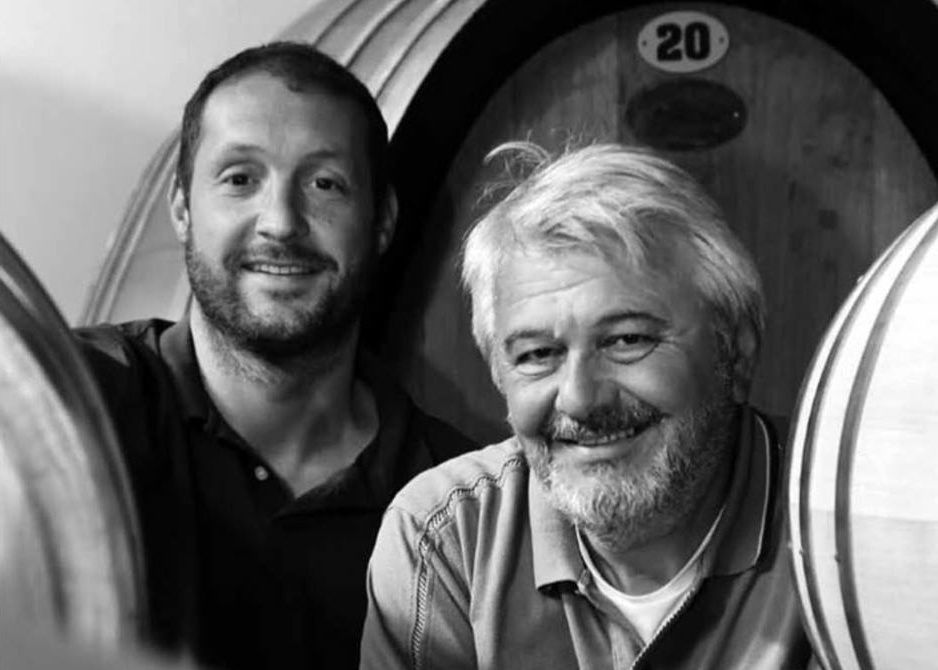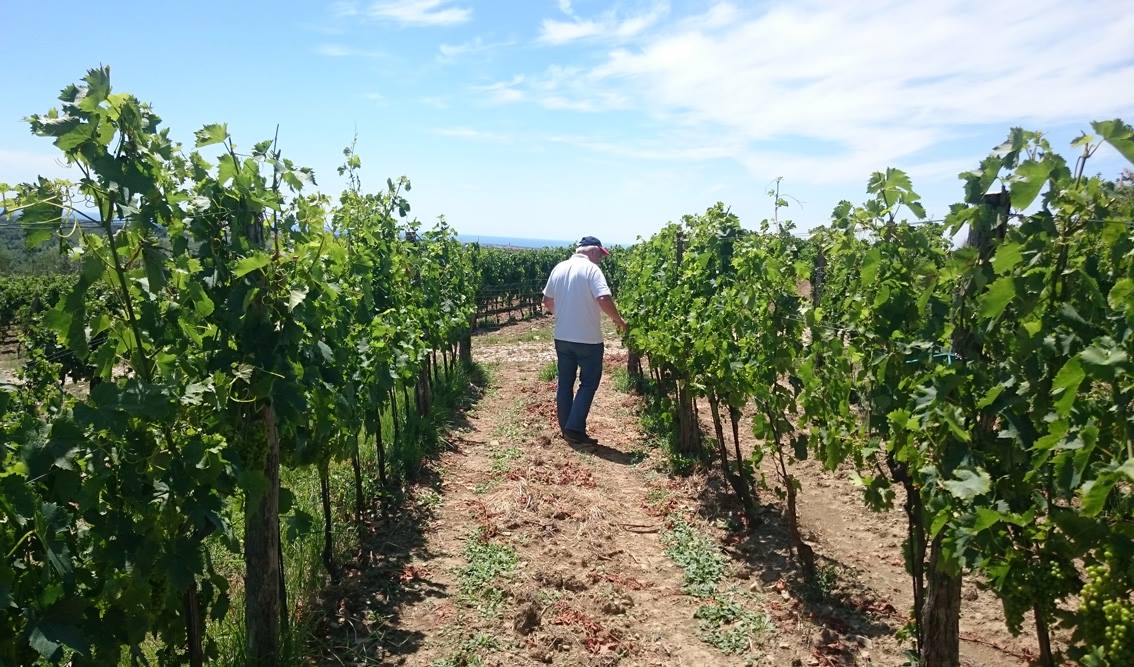Best of Istria: Giorgio Clai's Wines
December 9, 2018 — In the first article of the Best of Istria series find out about the famous Istrian winemaker Giorgio Clai, his philosophy and why his wines are some of the best you'll find in Croatia.
Up until ten or so years ago, the entire Istrian premium wines production scene could've been narrowed down to several names. Today, there are more than twenty regional winemakers comprising the Istrian winemaking elite, with Giorgio Clai of Clai Winery being one of them.
With more than 20 years in the restaurant business under his belt — all the while "making wine as a hobby" — in 2002 Giorgio decided to move back from Trieste, Italy to his native Istria with the idea of reinvigorating the Clai family estate which consequently pushed his beloved hobby into a vocation.
Photo: Dimitri Brečević & Giorgio Clai
And even though he was successful running the business on his own, several years ago, Clai joined forces with Dimitri Brečević of Piquentum Winery, a French-born winemaker who studied enology in Bordeaux, and upon graduation, also decided to move to his paternal homeland. Together, they are continuing to make top quality natural wines.
The Clai estate is located in Krasica, a small village just outside the medieval Grožnjan, with its vineyards and olive groves nestled among the lush rolling hills that stretch along the Mirna river valley. Though Clai's grape varieties are primarily ones indigenous to Istria — Malvazija, Refošk, and some Teran — he also cultivates Bordeaux giants like Merlot, Pinot, Chardonnay, and Sauvignon.
Praised as Istria's winemaking maverick, il grande Clai, as his friends and admirers call him, is known for producing some daringly individual wines though with an amazing level of balance and finesse, whereas Clai himself says that he'd rather have people dislike his wines than not recognize them.
Photo: Giorgio Clai in his vineyard
What's it all about
Giorgio Clai's philosophy is quite simple: he believes that every wine must fully express the grape variety and terroir and, if you work with respect for nature, no year is "good" or "bad" — the vintages are just different, depending on seasonal climate which determines wine's quality.
Adopting an approach to winemaking that first and foremost respects the environment, Clai has entirely eliminated the use of chemicals and pesticides, following the principles of ecological, biological and biodynamic agriculture. In fact, Giorgio likes to compare vines with humans: just as the use of antibiotics and synthetic vitamins weakens our immunity, so does the chemical treatment of vineyards weaken the vines.
As for the wine production itself, Clai relies on spontaneous fermentation and doesn't use any additional enzymes or selected yeasts; he uses wooden barrels for mellowing the wine and bottles it without sterile filtration or micro-filtering.
A load of bull... pardon, cow dung?
Not at all, it seems. One of the principles of biodynamics that Giorgio applies is the use of the so-called horn manure: cow horns are filled with fresh dung and buried in the vineyard for six months until the manure ferments, after which this rich compost is mixed with water and used for spraying the soil. This is said to enhance plant growth and improve the quality of the crops, whereas the spiritual theory behind it is that planting death and decay into the soil actually ushers vitality and breathes new life into the earth.
Apart from that, biodynamic viticulture relies on moon phases for planting, cultivation, and harvesting. Interestingly, up until recently, such rather unconventional methods have been considered pure madness among winemakers, but blind wine tastings are proving otherwise. With preconceived notions set aside, most wine experts are now recognizing that biodynamic wines are truly some of the best in the world, and Giorgio Clai's are no exception.
For more articles like this, make sure you follow TCN's dedicated page.
The Holy Trinity of Istrian Wine: Refošk
November 29, 2018 - The third and last in a series of articles unveiling the most important Istrian wines.
Choosing the third most iconic Istrian wine was a bit tricky. There is the famous Muškat which can be found in several different styles, though in Istria it is traditionally produced as a dessert wine, and comes as a close second right after Malvazija. When it comes to red wines, the Bordeaux varieties like Merlot, Cabernet Sauvignon, Cabernet Franc, and Petit Verdot show remarkable results in Istrian terroir and so their production is on the rise. In fact, Merlot is today probably more prevalent than Teran.
However, since we're talking about the Istrian "holy trinity," choosing any other variety than Refošk would be a sacrilege. This rich red enjoys the reputation of being the enfant terrible of Istrian wines, and because of its strong, tannic flavor, you either love it or hate it.
Although it was long mistakenly considered that Refošk is merely another name for Teran, and even that they are "first cousins," an extensive DNA analysis and comparison of these two varieties determined that they are actually two separate cultivars, despite their numerous genetical similarities.
According to a renowned Italian professor Antonio Calò and several other wine experts, Refošk is indigenous to northern parts of Italy, namely the Friuli-Venezia Giulia region, and in particular the Karst plateau which stretches across the Italian border to both southwestern Slovenia and northwestern Istria.
Refošk is dark ruby to violet in color; it has a pronounced fruity flavor with a slightly bitter aftertaste and exudes a rich aroma reminiscent of cherries and black currants with a touch of black pepper and vanilla from the wooden barrels. It is best paired with cured meats, especially Istrian game sausages, but also grilled red meat, and traditional dishes like boškarin žgvacet with gnocchi.
In Istria, this powerful, full-bodied red is most often used in various blends while Refošk varietal is a rare gem made only with superb vintages, and very few winemakers have managed to tame its wild nature.
For more related content, make sure you follow Total Croatia Wine.
The Holy Trinity of Istrian Wine: Malvazija
November 28, 2108 - The second in a series of three articles unveiling the most important Istrian wines.
Regarded as the absolute queen of Istrian vineyards, Malvazija is the most widespread white grape variety in Istria, and the second most widespread in Croatia. The name “Malvazija” is present in various forms (Italian: Malvasia; French: Malvoisie; English: Malvesie, or Malmsey), and is of Greek origin, derived from Monemvasía, a small town in the Peloponnese historically known for extensive export of the Malvasia grape family throughout the Mediterranean. However, Istarska Malvazija is today considered to be an authentic Istrian variety, as DNA analysis had confirmed that it is different from all the other Malvasia varieties.
These grapes are capable of producing wines in versatile styles, including dry, sparkling and sweet, while their color ranges from light yellowish to amber. Istrian Malvazija is typically described as a well-rounded, harmonious wine with a notable fruity and floral character. Malvazija's distinct aroma is reminiscent of acacia flowers, and the dominant fruit flavors are usually those of apple and apricot, whereas more ripe Malvazija wines also have a hint of bitter almond.
Though it was long believed that Malvazija is best enjoyed as young as possible, nowadays aged Malvazija wines are conquering the market as well. Ideally, this elegant Istrian white is aged in barrels made of acacia wood, as this perfectly complements its natural aroma, and in addition, some winemakers have recently started aging it in Georgian qvevri and amphorae, as well.
In Istria, you will easily find top quality Malvazija wine all across the peninsula, but the no.1 destination for its biggest fans is Brtonigla, a small town in the Istrian northwest which hosts the annual Festival of Istrian Malvasia.
On top of being a true Istrian favorite, Istrian Malvazija received world-class recognition as the first Croatian wine for which a special glass was designed by Georg Riedel of Riedel The Wine Glass Company himself. The Malvasia Istriana glass was chosen by 50 Croatian wine experts and was presented at the 2013 Vinistra wine fair in Poreč.
Depending on the style, the versatile Malvazija wines are very food friendly: they are typically enjoyed with a number of light pasta dishes, seafood, and white fish, but they also pair well with various desserts.
For more related articles, make sure you follow our designated gourmet page.
The Holy Trinity of Istrian Wine: Teran
November 26, 2018 - The first in a series of three articles unveiling the most important Istrian wines.
Istrian wine number one and at the same time one of the key domestic red varieties, Teran holds a special place in Croatian winemaking history. It was supposedly first mentioned in the 13th century, and by the 1880s it was the most widespread grape variety in Istria, planted on 90% of all vineyards.
The wine's strong character is said to be evident while the grapes are still on the vines, as Teran grows in large clusters of densely packed berries with highly resistant skins. Teran achieves its best quality in Istrian inland but also on northwestern Istria's red soils which are blended with calcareous stone, and thus makes the perfect setting for the fertile growth of this red grape variety that seems to absorb the mineral, iron-like quality of these soils in its grapes.
Teran has an intense, deep ruby red color with a distinctive purple hue, and you will often hear Istrians say that it is the color of hare's blood. Depending on vintage and terroir, Teran can make earthy, full-bodied robust red wines, both as a varietal and in various blends, but contrary to conventional thought, you can also find Teran that is lighter, more fresh and fruity in character, exuding a distinctively bold aroma of wild berries.
The Istrian giant among wines, Teran has come a long way from the wine of Istrian farm workers and domestic households. It is best at a temperature of about 18-20 °C and traditionally paired with the fragrant Istrian truffles, game and different red meat dishes, but also prosciutto and aged cheeses.
In wintertime, as an old Istrian custom, Teran is traditionally enjoyed as a warm beverage called Istarska supa: the lukewarm wine flavored with sugar, black pepper, and olive oil is served in a clay or ceramic jug, sided with grilled sourdough bread which is to be soaked in it.
For more related articles, make sure you follow our designated gourmet page.

